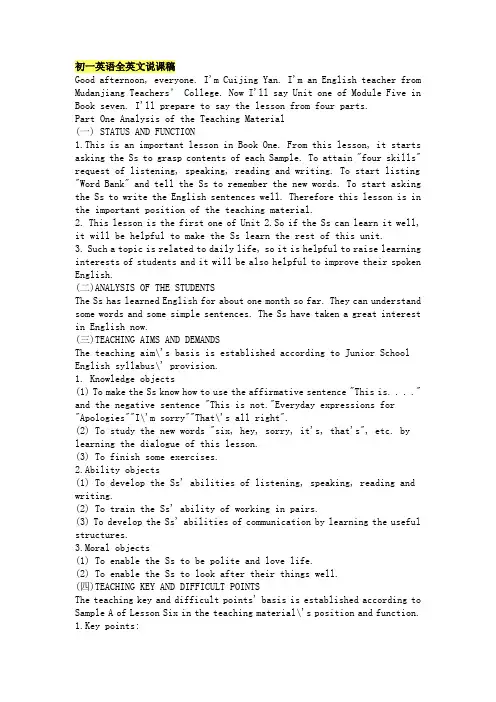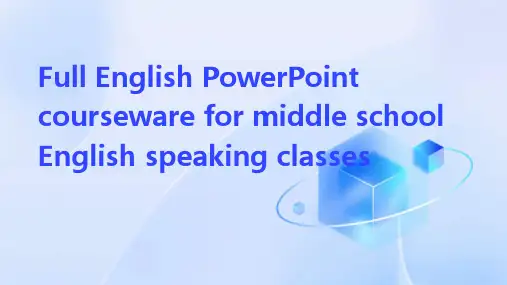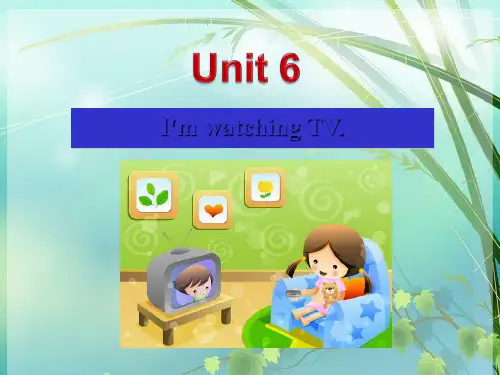初中英语说课ppt模板
- 格式:ppt
- 大小:6.59 MB
- 文档页数:45

初一英语全英文说课稿Good afternoon, everyone. I'm Cuijing Yan. I'm an English teacher from Mudanjiang Teachers’ College. Now I'll say Unit one of Module Five in Book seven. I'll prepare to say the lesson from four parts.Part One Analysis of the Teaching Material(一) STATUS AND FUNCTION1.This is an important lesson in Book One. From this lesson, it starts asking the Ss to grasp contents of each Sample. To attain "four skills" request of listening, speaking, reading and writing. To start listing "Word Bank" and tell the Ss to remember the new words. To start asking the Ss to write the English sentences well. Therefore this lesson is in the important position of the teaching material.2. This lesson is the first one of Unit 2.So if the Ss can learn it well, it will be helpful to make the Ss learn the rest of this unit.3. Such a topic is related to daily life, so it is helpful to raise learning interests of students and it will be also helpful to improve their spoken English.(二)ANALYSIS OF THE STUDENTSThe Ss has learned English for about one month so far. They can understand some words and some simple sentences. The Ss have taken a great interest in English now.(三)TEACHING AIMS AND DEMANDSThe teaching aim\'s basis is established according to Junior School English syllabus\' provision.1. Knowledge objects(1) To make the Ss know how to use the affirmative sentence "This is. . . ." and the negative sentence "This is not."Everyday expressions for "Apologies""I\'m sorry""That\'s all right".(2) To study the new words "six, hey, sorry, it's, that's", etc. by learning the dialogue of this lesson.(3) To finish some exercises.2.Ability objects(1) To develop the Ss' abilities of listening, speaking, reading and writing.(2) To train the Ss' ability of working in pairs.(3) To develop the Ss' abilities of communication by learning the useful structures.3.Moral objects(1) To enable the Ss to be polite and love life.(2) To enable the Ss to look after their things well.(四)TEACHING KEY AND DIFFICULT POINTSThe teaching key and difficult points' basis is established according to Sample A of Lesson Six in the teaching material\'s position and function.1.Key points:(1).To help the Ss to communicate with each other.(2).To enable the Ss to study in groups and co-operate skillfully.(3).To develop the Ss' interest in English.2.Difficult points:(1) How to make dialogues and act them out.(2) How to write the right whole sentences.(五) TEACHING AIDSMulti-media computer, Tape recorder, Software: Powerpoint or Authorware, school things and so on. They will be needed in this lesson.Part Two The Teaching Methods1. Communicative teaching method2. Audio-visual teaching method3. Task-based" teaching methodAs we all know: the main instructional aims of learning English in the Middle School is to cultivate students' abilities of listening, speaking, reading, writing and their good sense of the English language. So in this lesson I'll mainly use "Communicative" teaching method, "Audio-visual" teaching method and "Task-based" teaching method. That is to say, I'll let the Ss to get a better understanding of the key structure of the dialogue. I'll give the Ss some tasks and arrange five kinds of activities: talking, guessing games, watching CAI, acting out Sample A and having a competition.Teaching special featuresTo use these methods are helpful to develop the Ss' thought.Part Three STUDYING WAYS1.Teach the Ss how to be successful language learners.2.Let the Ss pass \"Observation-Imitation-Practice \" to study language.3.Teach the Ss how to master dialogues and how to communicate with others. Teaching special features:Let the Ss communicate with each other and adopt competition methods to develop the Ss' keen interest in English.Part Four Teaching ProcedureI'll finish this lesson in four steps. First I'll divide the Ss into four groups and bring a competition into the class. At last let's see which group is the winner.Step1 Warm-up1. Free talk between T and Ss .Such as: Hi, I'm . . . . What's your nameThis is . How do you doWho is he/she How are youWho can count from 1to 5What's this in English etc.2.A game: Ask the Ss to give T some school things. For example:T: Give me your book.(ruler, box, pen, table, knife, etc.)T: This is your book. This is not my book. It's your book. etc.In this course I'll ask them to make a dialogue group by group without repetition. Find out which group will make the most dialogues. Purpose of my designing: I think it is important to form a better English learning surrounding for the Ss by imitating and at the same time it is necessary to provide situations to review learned knowledge.Step2. PresentationThis course is very important. I'll mainly talk about this step.I'll use CAI to present the whole dialogue. Arrange some situations to help Ss understand Sample A.First scene: There is a bag on the floor. B is picking it up and get ready to leave. Now A is talking with B.A: Hi, B. How are you todayB: I'm fine, thank you. And youA: I'm fine, too. Oh, this is my bag.B: No, this is not your bag. It's my bag.A: (Look closely) Oh, I'm sorry.B: That's all right.(At the same time, C is running up and hitting A.)C: Oh, I'm sorry.A: That's OK.I'll write the key points on the Bb while they are watching. After watching, I'll teach them to read the words and sentences on the Bb. Make sure they can read them well.Purpose of my designing: To present Sample A by CAI is much easier for the Ss to learn and grasp the meanings. CAI can provide a real situation with its sound and picture and it makes the relationships between the Ss better.Step3.PracticeFirst play the tape recorder. Let the Ss listen and imitate the dialogue. Pay attention to their pronunciation and intonation. In this step the Ss are required to practise the Sample in pairs by reading the dialogue aloud. This step is employed to make the Ss grasp the Sample .At last I'll ask the Ss to think hard and act it out with a partner according to Sample A. Then find out which group will act it out well. I'll give them red stars. Purpose of my designing: This step is employed to make the Ss get the general idea of the dialogue as a whole one. At the same time let the Ss have a chance to practise their listening and spoken ability.Step4.ProductionIn this step I'll give the Ss a free space to show their abilities. Second scene: The Ss are having a picnic. It's hot and they take off their coats and put them together. They are singing and dancing, laughing and chatting. After the picnic, they begin to look for their coats. D and E are talking. F and G are talking. etc.After watching, I'll give the Ss some tasks to make similar dialogues without repetition and find out which group will make more dialogues. Purpose of my designing: "Task-based" teaching method is used here to develop the Ss' ability of communication and also their ability ofco-operation will be well trained. Tell the Ss we should be polite and take good care of our things. We should love our life. I think proper competition can arouse the Ss' interest in English learning. If the Ss can finish this task well, they will benefit a lot in their spoken English.2.Skill 1 Model 1.I'll ask four Ss of the groups to write these sentences on the Bb in the four lines.Then check their handwriting, correct their mistakes. Find out who will write well and whose handing is the best.3.Finish the Ss' workbook.Purpose of my designing: To check the knowledge Ss have learned in this lesson.Step5.Homework:(1)Recite the words as many as possible after class.(2)Make a dialogue according to Sample A and write it in the exercise book. Purpose of my designing: I think homework is so important that the Ss should speak English as much as they can in class or after class. It is necessary for the Ss to do some extensive exercises after class to consolidate the knowledge they learned.Blackboard DesignLesson Six Sample ASix This is my.hey This is not your. . . .sorry It's my. . . . Picture it's=it is Oh, I'm sorry.that's=that is That's all right/OK.。







英语说课09英本5班刘婷婷ContentsAnalysis of Teaching MaterialTeaching Learning Methods Teaching ProceduresDesign of the blackboard4123Part 1 Analysis of Teaching MaterialStatus and FunctionThe article comes from Unit 1 section A 1a-2c ballbook. This is an important lesson. From this lesson, itstarts asking the Ss to grasp contents of eachSample. To attain “four skills” request of listening,speaking, reading and writing. To start listing “WordBank” and tell the Ss to remember the new words. Tostart asking the Ss to write the English sentenceswell. Therefore this lesson is in the important positionof the teaching material. Such a topic is related todaily life, so it is helpful to raise learning interests ofstudents and it will be also helpful to improve theirspoken English.(1)To enable the Ssto understandand speak: whatis your name?My name is Gina,Make sure thatSs can usethese sentencesin real situations.(2) To help Ss tofinish the wholedialogue. (1)To develop Ss’abilities oflistening andspeaking.(2)To train the Ss’ability of workingin groups.(3) To foster Ss’abilities ofcommunication .1)To foster Ss’consciousnessof good co-operation andpropercompetition.(2)To enable Ss toact naturally .(1)To help Ss learnhow to greetand askothers’names.(2)To enable Ss tostudy in groupsand co-operateskillfully.(3) To develop Ss’interest inEnglish.➢Aims on the knowledge ➢Aims on the abilities➢Aims on theemotion➢Key-points of thislesson◆Teaching aimsDescription of teaching aims❖Teaching methodsAs we all know: the main instructional aims of learningEnglish is to cultivate pupils’ basic abilities of listening and speaking and their good sense of the English language. So in this lesson I’ll mainly use “Task-based” teaching method.That is to say, I will let the Ss learn in real situations, finish a task by making a survey to help the Ss to get a betterunderstanding of the key structure of the dialogue. I willarrange four kinds of activities: singing, guessing game,finishing a survey and having a competition. And in thislesson a recorder, CAI, school things and a printed form will be needed. Students should prepare some school things.❖Learning methods①Teach the Ss how to be successful language learners.②Get the Ss to form good learning habits.③Teach the Ss how to communicate with others and takecompetition methods to develop the Ss interest in English.Warm-up andreviewPresentationHomeworkPractice and ProductionStep1Step2Step4Step3Part 3 Teaching ProceduresStep 1 Warm up and reviewWarm upfour two three four,hands on knees▪one two three four ,clap your hands ▪two two three four,stomp your feet ▪three two three four,nod your head❖Purpose:❖It is important toform a better English learning surrounding for the Ss by singing and doing some total physical response and at the same time it providessituations to review learned knowledgefor the next step.Step 2 PresentationS4Answer S3’s questions ,ask anyone in the classthe questions .S1Greeting with S2,and introduce himself and ask his name. For example :hi, my name is…what is your name ?S3Answer S2’s questions,introduce S2’s conditions and ask S4 the same questions.S2Answer S1 questions and ask S3 what is S1’s name and introduce herselfPurpose of this step❖Play the game to present the key structures one by one is much easier for the Ss to learn and grasp the meanings. Proper competition can arouse the Ss’interest in English learning❖The game can provide a real situation for the Ss to understand the dialogue and the relationshipsbetween people better. Tell the Ss we should show our loveliness to the SsStep 3 Practice and production Divide Students to 4 groups ,practice together in groupsand finally choose the best group ,give the prize.G1G2G3G4Purpose of practice and production❖Task-based teaching method is used here to develop Ss’ ability of communication and also their ability of co-operation will be well trained.❖To check the knowledge Ss have learned in this period.Step4 HomeworkRevision is so important that Ss should speak English as much as they as in class or after class. It is necessary for the Ss to do some extensive exercises after class to consolidate the knowledge they learned.Blackboard design❖New words: what, is , your ,name ,my, etc.❖The phrase: what’s your name?My name is …9英本5班刘婷婷Thank you for your appreciation !!。
![初中英语说课课件(全英文)[优质PPT]](https://uimg.taocdn.com/b55ddc33f12d2af90242e6e4.webp)
